Re-use of this resource is governed by a Creative Commons
Attribution-
Noncommercial-Share Alike 4.0 Licence International
https://creativecommons.org/licenses/by-nc-sa/4.0/
Noncommercial-Share Alike 4.0 Licence International
https://creativecommons.org/licenses/by-nc-sa/4.0/
FE simulation of a 4-Stage Forging Process
The production of gudgeon pins (the pins that hold together
the two halves of a hinge) can be visualised well with the help of a
finite-element mesh.
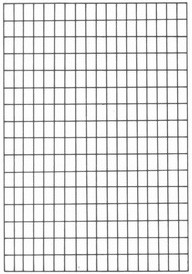
Stage 1: Upsetting
The starting billet is compressed until it fills the
die into which it has been placed.
Reproduced with permission - Figs 7.54, 7.55, 7.57 from
Rowe, Sturgess, Hartley and Pillinger [2]. Cambridge University Press
FE simulation of a 4-Stage Forging Process
The production of gudgeon pins (the pins that hold together
the two halves of a hinge) can be visualised well with the help of a
finite-element mesh.
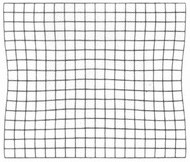
Stage 1: Upsetting
The starting billet is compressed until it fills the
die into which it has been placed.
Reproduced with permission - Figs 7.54, 7.55, 7.57 from
Rowe, Sturgess, Hartley and Pillinger [2]. Cambridge University Press
FE simulation of a 4-Stage Forging Process
The production of gudgeon pins (the pins that hold together
the two halves of a hinge) can be visualised well with the help of a
finite-element mesh.
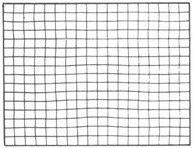
Stage 2: Indentation
The billet is indented, providing a guide for the punch
in the following stage.
Reproduced with permission - Figs 7.54, 7.55, 7.57 from
Rowe, Sturgess, Hartley and Pillinger [2]. Cambridge University Press
FE simulation of a 4-Stage Forging Process
The production of gudgeon pins (the pins that hold together
the two halves of a hinge) can be visualised well with the help of a
finite-element mesh.
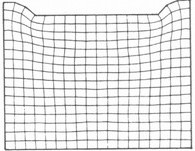
Stage 2: Indentation
The billet is indented, providing a guide for the punch
in the following stage.
Reproduced with permission - Figs 7.54, 7.55, 7.57 from
Rowe, Sturgess, Hartley and Pillinger [2]. Cambridge University Press
FE simulation of a 4-Stage Forging Process
The production of gudgeon pins (the pins that hold together
the two halves of a hinge) can be visualised well with the help of a
finite-element mesh.
The grid distortions produced during the various process
stages agree very well with experimentally observed distorted grids.
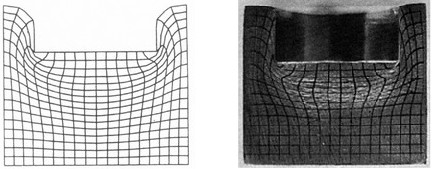
Stage 3: Backward Extrusion
The indented slug is backward extruded leaving a cup
shape.
Reproduced with permission - Figs 7.54, 7.55, 7.57 from
Rowe, Sturgess, Hartley and Pillinger [2]. Cambridge University Press
FE simulation of a 4-Stage Forging Process
The production of gudgeon pins (the pins that hold together
the two halves of a hinge) can be visualised well with the help of a
finite-element mesh.
The grid distortions produced during the various process
stages agree very well with experimentally observed distorted grids.
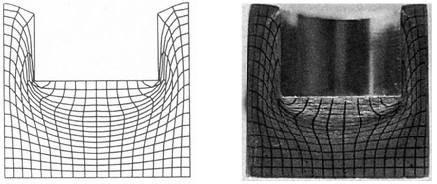
Stage 3: Backward Extrusion
The indented slug is backward extruded leaving a cup
shape.
Reproduced with permission - Figs 7.54, 7.55, 7.57 from
Rowe, Sturgess, Hartley and Pillinger [2]. Cambridge University Press
FE simulation of a 4-Stage Forging Process
The production of gudgeon pins (the pins that hold together
the two halves of a hinge) can be visualised well with the help of a
finite-element mesh.
The grid distortions produced during the various process
stages agree very well with experimentally observed distorted grids.
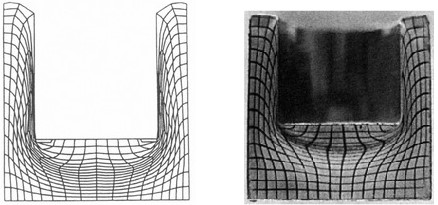
Stage 3: Backward Extrusion
The indented slug is backward extruded leaving a cup
shape.
Reproduced with permission - Figs 7.54, 7.55, 7.57 from
Rowe, Sturgess, Hartley and Pillinger [2]. Cambridge University Press
FE simulation of a 4-Stage Forging Process
The production of gudgeon pins (the pins that hold together
the two halves of a hinge) can be visualised well with the help of a
finite-element mesh.
The grid distortions produced during the various process
stages agree very well with experimentally observed distorted grids.
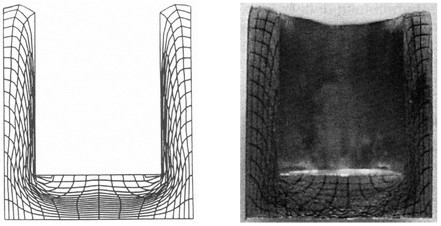
Stage 3: Backward Extrusion
The indented slug is backward extruded leaving a cup
shape.
Reproduced with permission - Figs 7.54, 7.55, 7.57 from
Rowe, Sturgess, Hartley and Pillinger [2]. Cambridge University Press